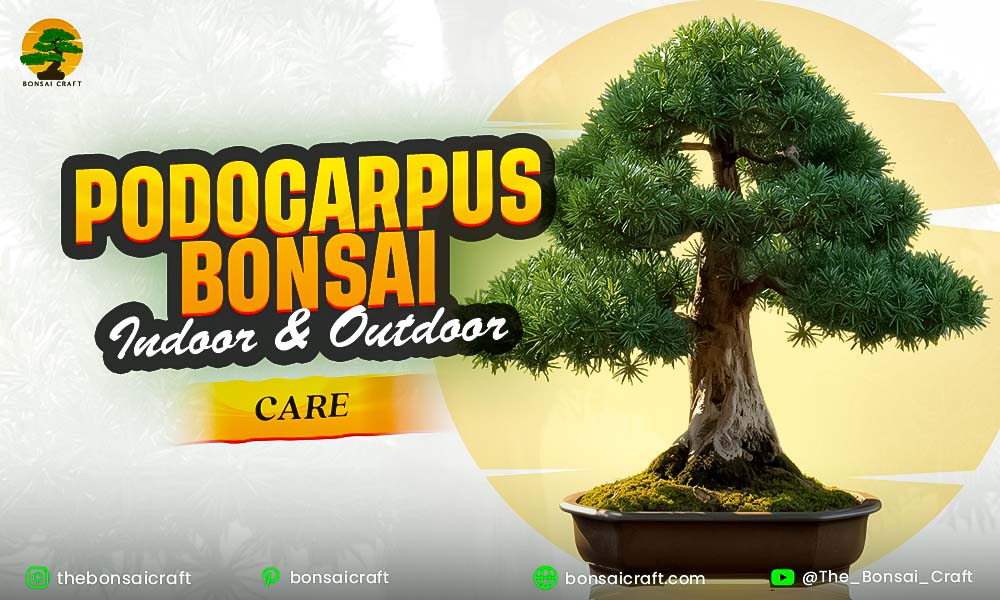
The Podocarpus bonsai, also known as the Buddhist Pine, is a stunning evergreen tree admired for its dense foliage, graceful shape, and easy adaptability to both indoor and outdoor environments. Whether you’re cultivating a bonsai Podocarpus tree for meditative calm or artistic expression, understanding proper care techniques will help your tree thrive year-round.
As a bonsai enthusiast and horticulture expert, I’ve seen how the Podocarpus bonsai plant can transform a space — symbolizing resilience and spiritual peace. This guide combines hands-on experience, expert horticultural advice, and scientifically backed care principles to help you master Podocarpus bonsai care both indoors and outdoors.
What Is a Podocarpus Bonsai (Buddhist Pine)?
A Podocarpus bonsai is a miniature form of the Podocarpus macrophyllus, commonly called the Buddhist Pine tree. It’s an evergreen conifer native to Asia, known for its needle-like leaves, upright growth, and deep green foliage. This bonsai is valued for its elegant form, longevity, and adaptability to diverse environments.
The Buddhist Pine bonsai has spiritual significance in East Asian cultures, symbolizing purity, wisdom, and endurance. It’s popular among bonsai artists because of its flexible branches and tolerance to pruning.
Podocarpus Bonsai Characteristics
The bonsai Podocarpus is a hardy species that thrives in warm, humid climates. It features narrow, pointed leaves that stay vibrant green throughout the year.
Key traits include:
- Scientific name: Podocarpus macrophyllus
- Common name: Buddhist Pine
- Family: Podocarpaceae
- Growth type: Evergreen conifer
- Ideal climate: Tropical to subtropical
- Sunlight: Full to partial sunlight
- Indoor suitability: Excellent with proper lighting and humidity
Its refined appearance and year-round greenery make it ideal for home or office décor — perfect for those seeking a peaceful natural touch.
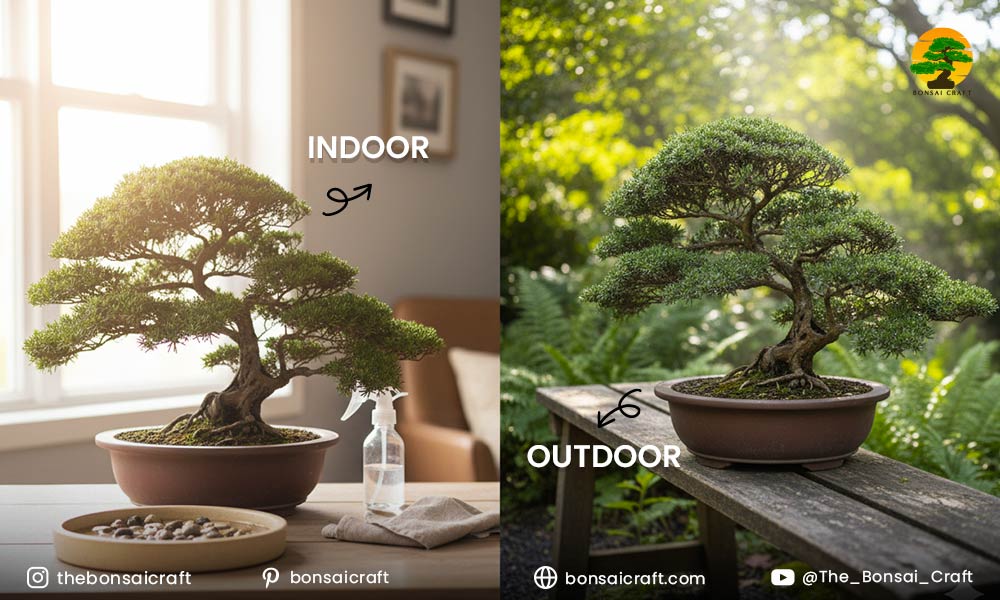
Is Podocarpus Bonsai Indoor or Outdoor?
The Podocarpus bonsai can grow both indoors and outdoors, but it prefers bright, indirect sunlight and moderate humidity. Indoors, place it near a south-facing window; outdoors, ensure partial shade during intense summer heat.
Indoor Care:
If grown as a Podocarpus indoor bonsai, maintain steady temperature and humidity. The Buddhist Pine adapts well to indoor conditions if it receives:
- Bright, indirect light (6–8 hours daily)
- Regular misting or a humidity tray
- Temperature between 60–80°F (16–27°C)
Outdoor Care:
When kept outdoors, your bonsai Podocarpus plant benefits from natural airflow and sunlight. Protect it from frost or direct midday heat, especially in tropical or arid climates.
How to Care for a Podocarpus Bonsai Tree
To care for a Podocarpus bonsai tree, provide bright light, moderate watering, and well-draining soil. Fertilize monthly during the growing season and prune regularly to maintain shape. Keep it in stable humidity and protect from extreme temperatures.
1. Light Requirements
The Buddhist Pine bonsai loves bright, filtered sunlight. Place your tree where it receives at least 4–6 hours of indirect light daily. If growing indoors, use a grow light during darker months.
2. Watering Schedule
- Water when the top 1 inch of soil feels dry.
- Avoid overwatering; stagnant moisture leads to root rot.
- Use soft, room-temperature water for best absorption.
Consistent watering supports healthy needle color and steady growth.
3. Soil Mix
A well-draining bonsai mix is crucial. Combine:
- 40% Akadama (for moisture balance)
- 30% pumice
- 30% lava rock or coarse sand
This mixture ensures proper aeration and prevents waterlogging.
4. Humidity & Temperature
The Podocarpus bonsai tree thrives in 50–70% humidity. Indoors, use a humidity tray or mist regularly. Avoid placing it near air conditioners or heating vents.
Maintain stable temperatures between 60–80°F (16–27°C).
5. Fertilizing Schedule
Feed your bonsai Podocarpus plant with a balanced liquid fertilizer (10-10-10) every 4–6 weeks during the growing season (spring to early autumn). Reduce feeding during winter dormancy.
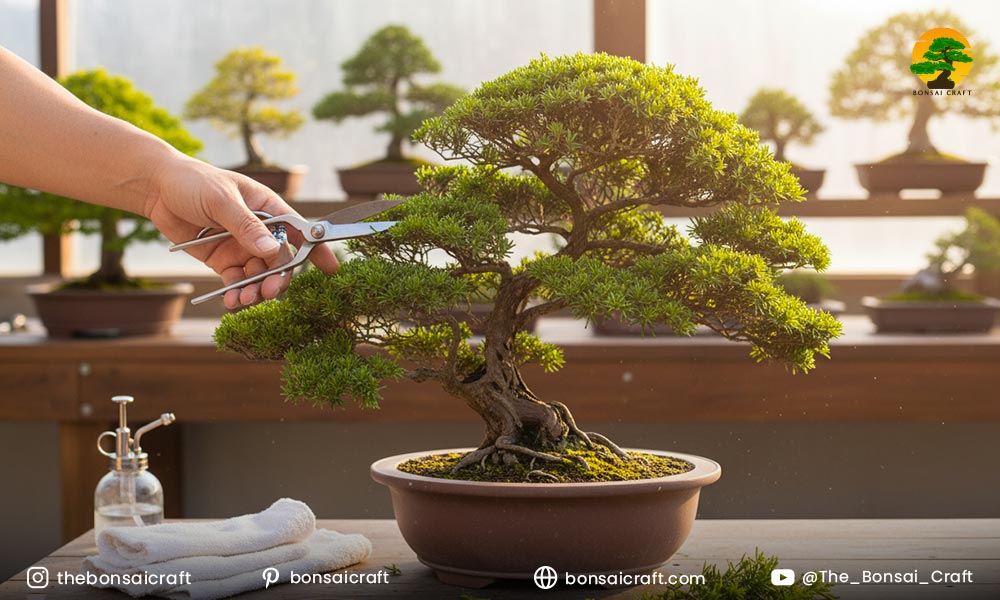
Podocarpus Bonsai Pruning and Shaping
Pruning a Podocarpus bonsai involves trimming new shoots to maintain compact growth and desired shape. Regular pruning encourages dense foliage and balanced branch structure.
When to Prune
Prune your Buddhist Pine bonsai during spring and early summer, when it actively grows. Avoid heavy pruning in winter.
How to Prune Properly
- Use sharp bonsai shears.
- Trim new shoots back to 2–3 leaves.
- Remove crossing or overly dense branches.
- Clean cuts prevent fungal infection.
Wiring and Shaping
Wiring helps create elegant curves and balanced form. Wrap aluminum wire gently around branches and adjust over 2–3 months. Avoid over-tightening to prevent bark damage.
Pro Tip: For formal upright or slanting styles, prune gradually to refine structure without stressing the tree.
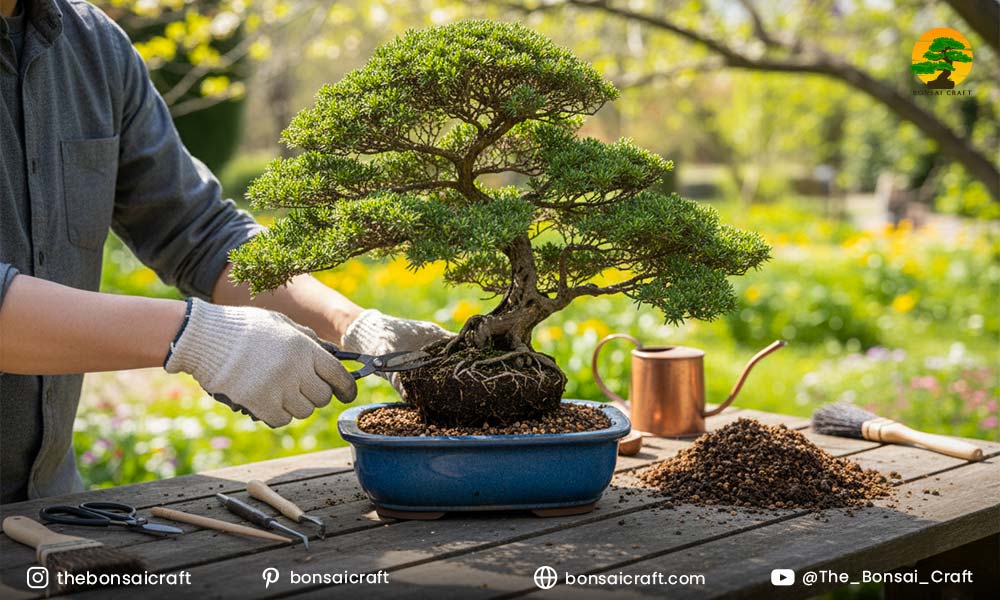
Repotting a Bonsai Podocarpus Plant
Repot your bonsai Podocarpus every 2–3 years in spring to refresh the soil and trim excess roots. Use a shallow bonsai pot with proper drainage.
Steps to Repot:
- Gently remove the tree from its pot.
- Trim one-third of the roots.
- Replace old soil with fresh bonsai mix.
- Water thoroughly after repotting.
Repotting ensures nutrient renewal and root health, which are vital for long-term vitality.
Common Problems and Solutions
- Yellowing Leaves:
Often caused by overwatering or poor drainage. Allow the soil to dry before watering again. - Leaf Drop:
Sudden temperature shifts or low light can cause leaf loss. Keep the environment stable. - Pests (Spider Mites, Scale, Aphids):
Wipe leaves with neem oil or mild insecticidal soap. - Slow Growth:
Lack of nutrients or insufficient sunlight can stunt growth. Increase fertilizer frequency and check light exposure.
Maintaining consistent care prevents most Podocarpus care issues.
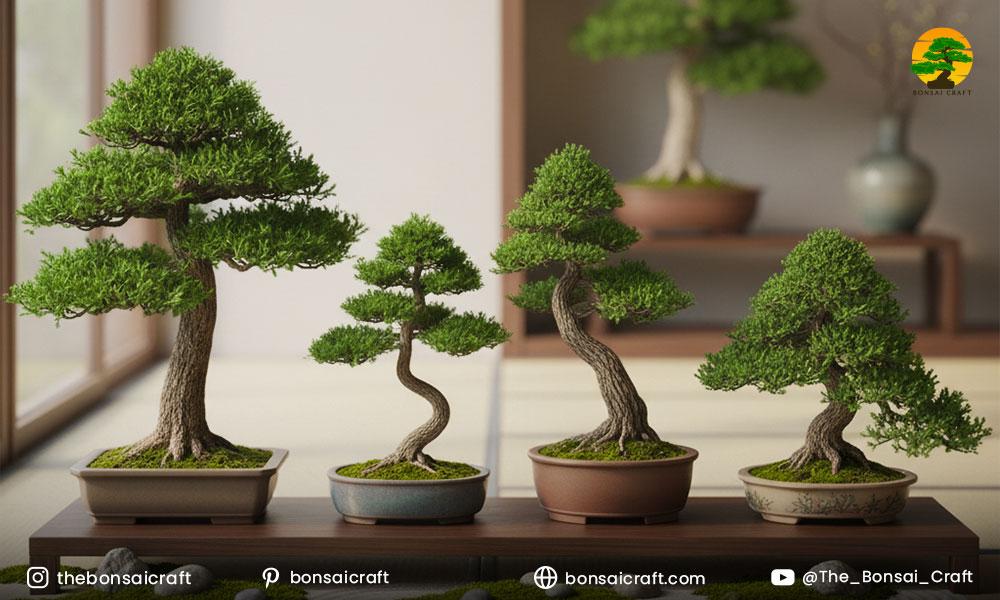
Podocarpus Bonsai Indoor Styling Ideas
If you’re growing a Podocarpus indoor bonsai, enhance its aesthetic with creative styling:
- Formal upright (Chokkan): Classic, symmetrical structure.
- Informal upright (Moyogi): Natural, gentle bends in the trunk.
- Slanting (Shakan): Dynamic movement and visual depth.
- Cascade (Kengai): Elegant downward branches mimicking natural slopes.
Decorate with stones or moss for a Zen-inspired look that aligns with the Buddhist Pine plant’s spiritual heritage.
Bonsai Podocarpus Care Tips from Experience
As a long-time bonsai grower, here are my expert recommendations:
- Mist your Buddhist Pine bonsai daily during dry seasons.
- Rotate the pot weekly for even growth.
- Use rainwater or filtered water for healthier foliage.
- Avoid frequent relocation; Podocarpus bonsai trees prefer stability.
These simple yet effective habits help sustain a lush, vibrant bonsai that radiates natural harmony.
Conclusion
The Podocarpus bonsai, or Buddhist Pine, is a symbol of peace, balance, and endurance — ideal for both indoor and outdoor bonsai enthusiasts. Its glossy foliage, elegant form, and forgiving nature make it one of the most rewarding bonsai trees to grow.
From proper pruning and watering to repotting and humidity control, consistent care ensures your bonsai Podocarpus plant thrives for decades.
Expert Tip: Keep a seasonal care journal to monitor growth patterns, pruning schedules, and watering frequency — this builds your bonsai mastery over time.
FAQs About Podocarpus Bonsai (Buddhist Pine)
Is Podocarpus a good bonsai tree?
Yes, the Podocarpus bonsai tree is one of the best beginner-friendly evergreen bonsai species. It’s easy to shape, resilient, and thrives both indoors and outdoors with minimal maintenance.
How often should I water my Podocarpus bonsai?
Water your bonsai Podocarpus when the topsoil feels slightly dry. Typically, 2–3 times per week works well depending on humidity and temperature. Avoid letting the soil completely dry out or remain soggy.
Can I grow Podocarpus bonsai indoors year-round?
Yes, you can keep your Podocarpus indoor bonsai year-round if it receives bright, indirect sunlight and sufficient humidity. Supplement with grow lights during winter for optimal growth.
How do I prune a Podocarpus bonsai properly?
Trim back new shoots to maintain your bonsai Podocarpus plant’s compact shape. Perform light pruning regularly and major cuts during spring or summer to encourage dense growth and balanced form.
When should I repot my Podocarpus bonsai?
Repot every 2–3 years in early spring before active growth begins. This refreshes soil nutrients, prevents root congestion, and helps your Buddhist Pine bonsai stay healthy and vibrant.
What is the ideal temperature for a Podocarpus bonsai?
The Podocarpus bonsai tree prefers a temperature range of 60–80°F (16–27°C). Protect it from frost and extreme heat to maintain consistent, healthy growth.
Authority Sources:
- Bonsai Empire – Podocarpus Care Guide
- The Spruce – Growing Podocarpus Plants
